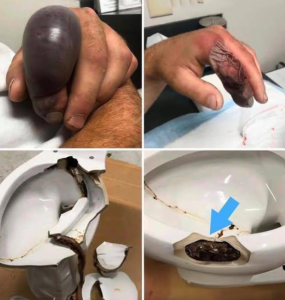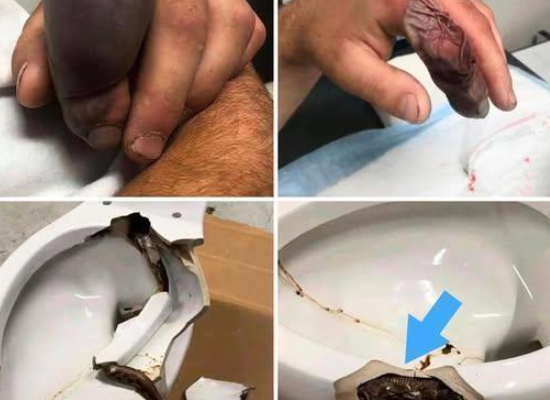
Toilet Terror: Shocking Attacks Leave Residents on Edge
In certain regions across the globe, the most private and ordinary human activity—using the toilet—has become a source of unexpected fear. Reports have emerged of people being attacked while using their bathrooms, incidents so bizarre and unsettling that they have sparked widespread concern, confusion, and even dark humor on social media. While many initially dismissed the stories as urban legends or exaggerations, local authorities and medical professionals confirm that these attacks are real, and in some cases, life-threatening.
A Place of Privacy Turned Dangerous
For most people, the bathroom is a place of safety, privacy, and routine. Yet in rural communities, urban slums, and even modern neighborhoods in certain countries, the act of sitting on the toilet has been disrupted by a terrifying menace.
Accounts vary, but the theme is consistent: while using their toilets, individuals were suddenly attacked by creatures lurking in the darkness, hiding within the plumbing, or waiting just beneath the surface. Victims describe the experiences as both painful and horrifying—moments when comfort was replaced by chaos.
The Attackers: Snakes, Rats, and More
Authorities and wildlife experts identify several culprits. In regions with poor plumbing infrastructure, rats and snakes are known to crawl up through sewage pipes.
-
Snakes in Toilets: Perhaps the most chilling stories involve snakes, particularly pythons and cobras. In Southeast Asia, Africa, and parts of Australia, residents have been bitten or constricted by snakes that slithered through pipes seeking water or prey. A man in Thailand made international headlines when a python latched onto him while he was seated on his toilet. His screams summoned neighbors, who rushed in to help free him.
-
Rats and Rodents: In densely populated cities, rats often travel through underground sewage networks. Their ability to squeeze through tight spaces allows them to emerge in toilets. Though bites are rare, the psychological trauma of seeing a rat surface while using the bathroom is enough to spark panic.
-
Insects and Amphibians: In tropical climates, large spiders, frogs, and even scorpions have been found inside toilets. Their stings or bites can lead to painful injuries, allergic reactions, or infections.
What makes these attacks so shocking is not only the pain they cause but also the violation of personal safety.
First-Hand Accounts
Several victims have shared their experiences publicly, turning their personal nightmares into cautionary tales.
One woman from rural India recalled entering her outhouse one evening. “I sat down, and within seconds I felt a sharp sting,” she explained. “When I jumped up, I saw a snake coiled in the bowl.” She survived but required anti-venom treatment at a hospital hours away.
In another case from Australia, a teenager lifted the toilet lid to find a redback spider waiting underneath. Fortunately, he spotted it before sitting, but the incident left him shaken for weeks.
Perhaps most shocking was the story of a man in South Africa, who was bitten by a venomous cobra while using his portable toilet during a camping trip. He required emergency surgery but lived to tell his tale.
Why Does This Happen?
Experts say these attacks occur at the intersection of urban development and natural habitats. Sewage systems, especially older ones, provide dark, damp corridors where animals can move freely. Toilets connected to these systems can inadvertently serve as gateways.
In rural areas, where outhouses and pit latrines are common, animals such as snakes and scorpions may be drawn by insects or shelter. In flood-prone regions, waterborne creatures sometimes surface through household toilets, particularly after heavy rains.
Dr. Alan Spencer, a wildlife biologist, explained: “Animals don’t see toilets the way we do. They are looking for food, water, or escape routes. Unfortunately, this means they sometimes cross paths with humans in the most unexpected and vulnerable situations.”
The Health Risks
Beyond the shock and fear, toilet attacks carry real health risks. Snakebites can be fatal without rapid medical treatment. Rat bites may transmit diseases like leptospirosis. Spiders and scorpions can inject venom that requires hospitalization. Even minor bites can lead to infections due to the unsanitary conditions of sewer systems.
Doctors also highlight the psychological toll. Victims often develop anxiety about using the bathroom. Some children who have heard stories from relatives refuse to use toilets alone, creating additional challenges for families.
Preventive Measures
Communities and individuals have responded with creative solutions to prevent toilet-related attacks:
-
Installing Screens and Barriers: Many households now fit their toilets with fine mesh screens inside the pipes, designed to block animals without obstructing water flow.
-
Keeping Lids Closed: Experts recommend always keeping the toilet lid shut when not in use, reducing the chances of animals escaping into living spaces.
-
Regular Inspections: Plumbing checks, especially in older homes, help detect cracks or openings where animals can enter.
-
Lighting and Awareness: In areas with outdoor toilets, residents are urged to carry flashlights and check the inside before sitting.
-
Community Education: Wildlife awareness campaigns teach people how to react if confronted by a snake or rat in the bathroom—remaining calm, avoiding sudden movements, and calling for professional help.
Social Media and the Spread of Fear
As frightening as these attacks are, they have also become the subject of memes, jokes, and viral videos. On platforms like TikTok and X (formerly Twitter), clips of snakes being pulled from toilets gather millions of views. Some users post exaggerated skits about “toilet monsters,” blending humor with genuine caution.
Yet, experts warn that the viral aspect can trivialize the danger. For victims, these attacks are not comedy but trauma. Still, the circulation of such stories raises awareness, which may ultimately save lives.
Governments Respond
Local governments in affected regions are stepping up. Some municipalities in India and Africa are upgrading sewage systems to make them less accessible to wildlife. In parts of Australia, snake-catchers are on call for emergency home visits, responding not only to backyards but also to bathrooms.
Public health agencies have also begun issuing advisories, particularly in rural areas, urging families to take preventive measures and seek medical help immediately after any bite or sting.
A Universal Reminder
Though these stories may seem like something out of a horror movie, they highlight a larger truth: human expansion continues to push into wildlife habitats. Toilets, an invention designed to bring hygiene and comfort, sometimes become unexpected contact points between people and nature.
The lesson is not only about caution but also about coexistence. As one wildlife conservationist remarked: “These animals don’t come looking to attack us—they’re following instincts, moving through the systems we’ve built. It’s up to us to engineer safer solutions.”
A Lasting Impact
For now, fear lingers in the minds of those who have heard or lived these stories. Some laugh nervously, others check twice before sitting down. In regions where attacks are common, bathrooms are no longer places of total relaxation.
Still, with increased awareness, better infrastructure, and community vigilance, experts believe the danger can be greatly reduced. Until then, one unsettling reality remains: in some parts of the world, sitting on the toilet is not just a routine—it’s a risk.

